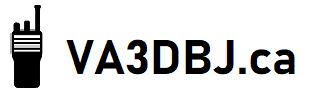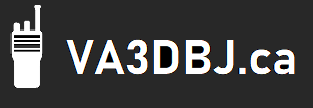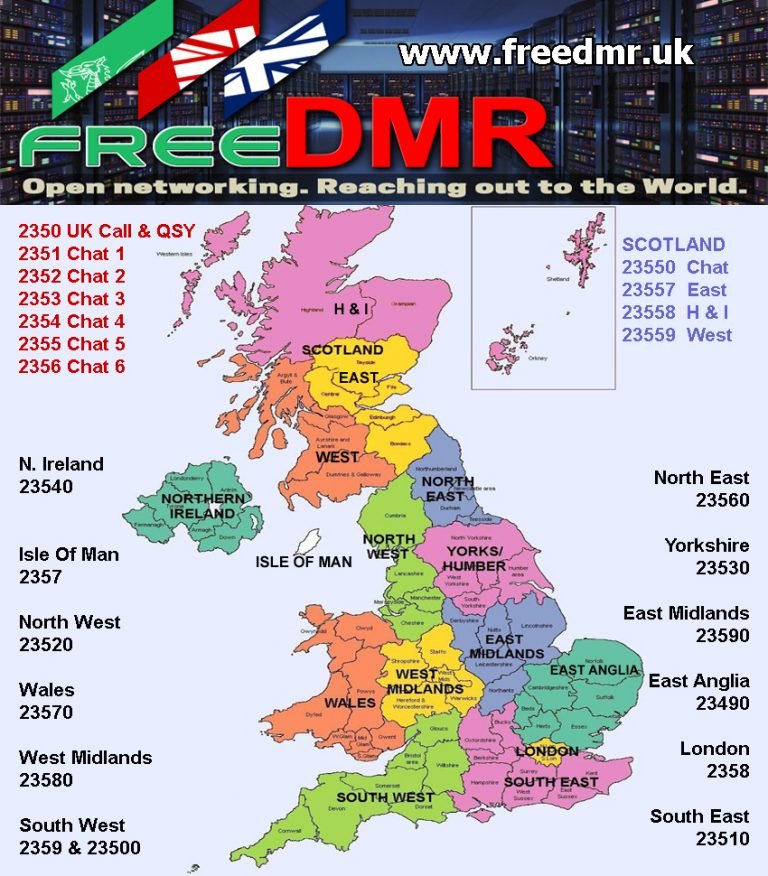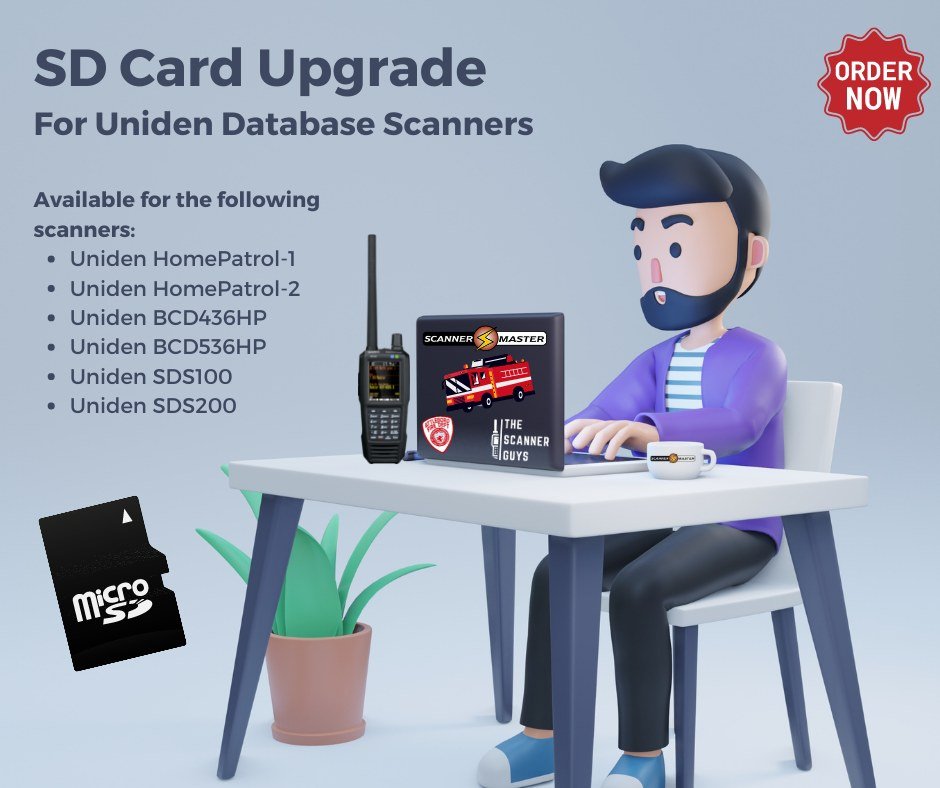DMR Network
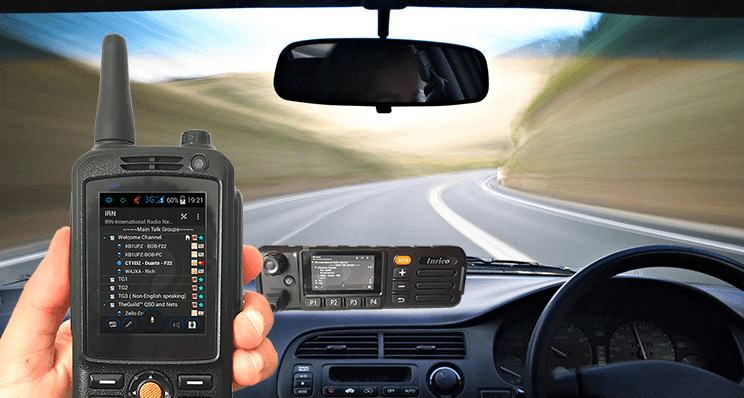
Digital mobile radio (DMR) is an open digital mobile radio standard defined in the European Telecommunications Standards Institute (ETSI) Standard TS 102 361 parts 1–4 and used in commercial products around the world. DMR, along with P25 phase II and NXDN are the main competitor technologies in achieving 6.25 kHz equivalent bandwidth using the proprietary AMBE+2 vocoder. DMR and P25 II both use two-slot TDMA in a 12.5 kHz channel, while NXDN uses discrete 6.25 kHz channels using frequency division. The standard has become popular within the amateur radio community due to the relative lower cost and complexity compared to other commercial digital modes.
DMR was designed with three tiers. DMR tiers I and II (conventional) were first published in 2005, and DMR III (Trunked version) was published in 2012, with manufacturers producing products within a few years of each publication.
The primary goal of the standard is to specify a digital system with low complexity, low cost and interoperability across brands, so radio communications purchasers are not locked into a proprietary solution. In practice, many brands have not adhered to this open standard and have introduced proprietary features that make their product offerings non-interoperable.
What makes DMR stand out from some of the other digital modes is that it utilizes TDMA (Time-Division Multiple Access) to divide a single frequency into 2 distinct “channels” or time slots. By doing this, you can have two conversations going on at the SAME TIME, using one frequency.
Imagine using one frequency while radio A is talking to radio B on time slot 1, and radio C is talking to radio D on time slot 2 … SIMULTANEOUSLY. Pretty neat, huh?
Here is a nice graphic from Retevis to help visualize and understand what is going on…

Although the graphic above relates to how a DMR repeater works, this same principal applies to using a simplex frequency as well.
Specifications
The DMR interface is defined by the following ETSI standards:
- TS 102 361-1: Air interface protocol
- TS 102 361-2: Voice and General services and facilities
- TS 102 361-3: Data protocol
- TS 102 361-4: Trunking protocol
The DMR standard operates within the existing 12.5 kHz channel spacing used in land mobile frequency bands globally, but achieves two voice channels through two-slot TDMAtechnology built around a 30 ms structure. The modulation is 4-state FSK, which creates four possible symbols over the air at a rate of 4,800 symbols/s, corresponding to 9,600 bit/s. After overhead, forward error correction, and splitting into two channels, there is 2,450 bit/s left for a single voice channel using DMR, compared to 4,400 bit/s using P25 and 64,000 bit/s with traditional telephone circuits.
The standards are still (as of late 2015) under development with revisions being made regularly as more systems are deployed and discover improvements that can be made. It is very likely that further refinements will be made to the standard, which will necessitate firmware upgrades to terminals and infrastructure in the future to take advantage of these new improvements, with potential incompatibility issues arising if this is not done.
DMR covers the RF range 30 MHz to 1 GHz.
There are DMR implementations, (as of early 2016), that operate as low as 66 MHz (within the European Union, in ‘Lo-Band VHF’ 66–88 MHz.)[citation needed]
The DMR Association and manufacturers often claim that DMR has superior coverage performance to analogue FM.[citation needed] Forward error correction can achieve a higher quality of voice when the receive signal is still relatively high. In practice, however, digital modulation protocols are much more susceptible to multipath interference and fail to provide service in areas where analogue FM would otherwise provide degraded but audible voice service. At a higher quality of voice, DMR outperforms analogue FM by about 11 dB. But at a lower quality of voice, analogue FM outperforms DMR by about 5 dB.[citation needed]
Where digital signal processing has been used to enhance the analogue FM audio quality then analogue FM generally outperforms DMR in all situations, with a typical 2–3 dB improvement for “high quality” voice and around 5 dB improvement for “lower quality” voice.[citation needed] Where digital signal processing is used to enhance analog FM audio, the overall “delivered audio quality” is also considerably better than DMR.[citation needed] However DSP processing of analog FM audio does not remove the 12.5 kHz requirement so DMR is still more spectrally efficient.
Tier I
DMR Tier I products are for license-free use in the 446 MHz band in the European Union.
This part of the standard provides for consumer applications and low-power commercial applications, using a maximum of 0.5 watt RF power. With a limited number of channels and no use of repeaters, no use of telephone interconnects, fixed/integrated antennas, and a talk timer of 180 seconds, Tier I DMR devices are best suited for personal use, recreation, small retail and other settings that do not require wide area coverage or advanced features.
Tier II
DMR Tier II covers licensed conventional radio systems, mobiles and hand portables operating in PMR frequency bands from 66-960MHz. The ETSI DMR Tier II standard is targeted at those users who need spectral efficiency, advanced voice features and integrated IP data services in licensed bands for high-power communications. ETSI DMR Tier II specifies two slot TDMA in 12.5 kHz channels.
DMR Tier II is based on the following ETSI standards.
- ETSI TS 102 361-1 Air interface
- ETSI TS 102 361-2 Voice and generic services and facilities
- ETSI TS 102 361-3 Data protocol
Tier III
DMR Tier III covers trunking operation in frequency bands 66-960MHz. The Tier III standard specifies two slot TDMA in 12.5kHz channels. Tier III supports voice and short messaging handling similar to MPT 1327 with built-in 128 character status messaging and short messaging with up to 288 bits of data in a variety of formats. It also supports packet data service in a variety of formats, including support for IPv4 and IPv6.
What Is A DMR Radio ID?
A Radio ID is a unique number assigned to you (and your callsign) by the RadioID.net Team. Like a telephone number or IP address, your Radio ID identifies you as a unique radio user on the various DMR networks and repeaters around the world. Because DMR is digital, we have so much more that we can do with the RF flowing to and from our radios. For example, because of Radio IDs we can see and display the callsign of the person talking to us on the radio face by the use of the RadioID.net Database. Every time you PTT your DMR radio, your Radio ID gets transmitted to the DMR network and everyone can see who you are. Pretty cool, right? BUT DON’T FORGET.. YOU MUST STILL ID BY VOICE TO BE LEGAL! Even though your callsign shows up in the network logs and on other users radios does not mean you are identifying yourself a licensed ham. You must ID like you do on analog.
So why else is this so cool? Identifying every radio and repeater uniquely with an ID enables the very essence of DMR networking to function. i.e making private calls to each other, organizing specific talkgroups for countries, states, regions, cities, clubs, special interest groups etc.
In short, a Radio ID enables you to talk to and hear only the people and traffic that you want to.
It’s totally free to get your Radio ID and you NEED ONE if you are going to have a DMR radio and use it. Is it the law? No. But you aren’t going to enjoy using DMR unless you have one, so do yourself a favor and get registered with RadioID.net as soon as you buy a DMR Radio.
Talk Groups
Talk Groups (TG) are a way for groups of users to share a time slot, without distracting and disrupting other users of the time slot. It should be noted that only one Talk Group can be using a time slot at a time. If your radio is not programmed to listen to a Talk Group, you will not hear that Talk Group’s traffic.
The DMR-MARC Mototrbo™ network supports a number of Talk Groups on TS1 including World Wide (TG1, PTT), North America (TG3), and World Wide English (TG13). TS2 is for local, state, and regional Talk Groups. The DCI/TRBO network uses TG3163 for North America and TG3161 for World Wide, and TG3 for World Wide English on TS2.
The Brandmeister network is very similar to DMR-MARC, but the talk groups and reflectors are organized some what differently. For example, Talkgroup 3129 on the MARC network might not be the same as Talkgroup 3129 on the Brandmeister network.
The Brandmeister network is the most popular at the moment with most users.
The DMR standard also supports private calls (one-to-one), encryption, and data. Private calls are not allowed by most of the amateur networks and many consider private calls not amateur friendly; private calls tie up a large number of repeater time slots across the network. Encryption is not legal on amateur radio in the USA but is allowed in Canada! Data and text messaging is supported on some networks.
For simplex traffic, the accepted standard in the amateur community is to use TG99 on TS1 with CC1.
Frequently Asked Questions:
What is a Static Talkgroup?
A static talkgroup is one that is permanently activated on a particular timeslot by the repeater sysop. This type of static assignment passes ALL traffic from the DMR network over the air on the timeslot it is assigned to.
For example, if a statewide talkgroup is assigned to the local repeater on timeslot 1, anytime someone keys that talkgroup on the network, regardless of where they are, the audio will be retransmitted locally.
In simple terms, this networks many repeaters together full-time for that particular talkgroup.
What is a Dynamic Talkgroup?
Dynamic talkgroups assignments are used for temporary activation on a timeslot on a particular repeater. This type of talkgroup functions for a set amount of time AFTER a local repeater user activates it by transmitting on a repeater using that talkgroup in their radio. When the timer expires and no local user has keyed up again for a set amount of time… the timeslot and the talkgroup and release and the repeater is again open only to the talkgroups that remain static.
For example, if you are traveling in British Columbia and wish to talk to a friend back home in Ontario, you could key up the Ontario talkgroup on a B.C. repeater that allows dynamic talkgroups and make a call on repeaters at home that have the Ontario talkgroup set as static. When you are done with your conversation, the dynamic timer will expire and the B.C. repeater will go back to normal.
MMDVM/Hotspots
Overview
A personal, low-power hotspot is a combination of hardware, firmware, and software that enables an amateur radio enthusiast with internet connectivity to link directly to digital voice (DV) systems around the world. Hotspots can link to DMR, P25, and NXDN talkgroups; D-STAR reflectors; YSF rooms; and so on.
Basically, hotspots are your own personal digital voice repeater and gateway, which can be really fun. Here’s a simplified diagram of what it looks like when you connect via your hotspot to a BrandMeister-hosted multiprotocol talkgroup, which enables people using different modes to talk with each other:

For some people, who doesn’t live within range of a digital voice repeater, a hotspot goes beyond being fun to being a critical key to accessing digital voice systems, a gift that opens doors to the whole wide world.
Overall, this is an exciting area of amateur radio that is evolving and progressing rapidly with some excellent work being done by some very innovative hams.
Background
This is an article about personal, low-power hotspots, also known as personal access points, not repeaters. (For info about digital repeaters, see: How to make a MMDVM Digital Repeater by N5AMD and Repeater Builders.)
- Many personal, low-power hotspots are boards that mount on computers like the Raspberry Pi, one is an all-in-one board, and some others are thumb drives that plug into computers. There’s even one that’s a handheld radio that plugs into a Raspberry Pi via USB.
- Some can handle many digital modes, including DMR, D-STAR, YSF, P25, NXDN, various cross modes, and POCSAG; others are limited to only one or a few modes.
- Most require a digital voice-capable radio to work with them (these typically have stubby or onboard ceramic antennas for nearby connectivity). There’s also another type that has its own AMBE® Vocoder chip so you can operate it without the need for a digital radio, for example, by using a headset with a microphone that is connected to the computer the hotspot is plugged into.
- Note: A core component of a digital radio is an AMBE® chip, which compresses the digitized signal and adds error correction. If a hotspot has its own AMBE® chip, it doesn’t need a digital radio. Alternatively, a hotspot can use an AMBE® chip for transcoding between modes, in which case, a digital radio is still needed.
I’ve been playing around with my first personal, low-power hotspot since May 26th of this year, and I have been very impressed with the little unit. It has opened a new spectrum in this hobby, with my DMR HT.
DMR Networks
Brandmeister Network
The Brandmeister Network was born from several worldwide hams and software engineers who joined together to create a digital repeater network consisting of master servers and peer repeaters all over the world. The network has over 1300 repeaters and more than 3000 hotspots across the globe and it’s growing every day!
Brandmeister is tailored to the Motorola TRBO technology and allows for DMR repeaters to connect worldwide via the internet and link systems together by utilizing organized Talkgroups.
The Brandmeister Network offers several neat features for amateur radio enthusiasts to take advantage of:
- Private Call
- Talkgroups
- APRS
- SMS Text Messaging
- D-Star Gateway
- Echolink Gateway
- Autopatch Call Gateway
- Roaming via Hytera Equipment
- and more…
TGIF Network
TGIF Network was started in October, 2018 By Robert K4WZV and Mitch EA7KDO.
They started the TGIF Network with just one talkgroup which became 31665, and about 5 Amateur Radio Operators joined the Network, at this time the system was running on a Raspberry pi.
Later on, Ty (KG5RKI) came on board to help improve the hblink code it was currently running on and move it to a cloud server, then later rewrote the backend to make what was called Callmgr. Michael (K5MRE) and Andy (G7LRR) also joined the team and created many of the features we enjoy on the website and plenty more behind the scene.
Over the course of the next year, the network quickly grew from just a few hundred users to just under 1,500.
The network now is home to around 340 active talkgroups available for all to use.
The main/original talkgroup is original 31665, and is sometimes referred to as the ‘Mothership’ by many.
All Amateur Radio Operators are welcome to join and try out what the network offers.
The Network is still growing rapidly. Last year, Pi-Star and Shark RF Openspot added the TGIF Network to their list of networks.
But this tale has not ended.. around the end of 2019, Ty (KG5RKI) could see limitations to how far Legacy would be able to scale with the growing number of clients.
So Ty took it upon himself to once again use his coding skills and knowledge of digital networking and in his spare time rewrite and design a network from the roots up which was codenamed ‘Prime’ and was open do beta testers during development. With Andy (G7LRR) as his partner in crime against the code, and Rob (K4WZV) having his back, the team is making fast progress at creating a great solution for ham radio operators around the world.
FreeDMR Network
The new system is derived from HBlink and is fully-open source and available on GitHUB. The server software allows the implementation of features as we would like to see them, making the software completely customisable to your needs. This also allows the response to issues and bugs more effectively. This system is bridged to other Servers, providing a frontend system with enhanced functionality. It also enabled repeaters to be able to communicate even if a Server upstream is down. An overview of the added functionality is below. Note, all of this functionality is optional and configurable.
On the 9 November 2020, the birth of a new way of working with DMR was born. A network name was devised and was called…
FreeDMR is the freedom for Repeater/Gateway Keepers and some Hotspots to have full control of what happens instead of being told what has to go where. We look forward to a great and bright future. FreeDMR is a DMR Network for Amateur radio users around the world.
FreeDMR is currently looking for OpenBridge connections to connect to a rapidly growing system. Open Source is here! FreeDMR – Open networking – Reaching out to the World.
New Canadian talk groups have been added!!
| Country | Talk Groups | Name |
|---|---|---|
| Canada | 302 | Canada Wide |
| Canada | 3020 | Newfoundland & Labrador & P.E.I. |
| Canada | 3021 | Nova Scotia |
| Canada | 3022 | Quebec |
| Canada | 3023 | Ontario |
| Canada | 3024 | Manitoba |
| Canada | 3025 | Saskatchewan |
| Canada | 3026 | Alberta |
| Canada | 3027 | British Columbia |
| Canada | 3028 | Nunavut, Yukon & NWT |
| Canada | 3029 | New Brunswick |
For more information, click here.
Local DMR Repeaters
The following DMR repeaters are available in the Durham Region area:
VE3OBI – Courtice – 442.1375 – CC1
VE3RWN – Cobourg – 444.9750 – CC1 (NEW!!)
VE3SBX – Ajax – 442.3625 – CC3
VE3LBN – Oshawa – 443.9875 – CC3
VA3WIK – Toronto – 442.1875 – CC4
VE3NUS – Toronto – 444.2875 – CC1
Monitoring DMR via Scanners
You can use the following to decode a DMR Transmission:
Uniden
- BCD325P2
- BCD996P2
- BCD436HP
- BCD536HP
- SDS100
GRE \ Radio Shack \ Whistler
- PSR-800
- Pro-668
- Pro-18
- WS1080
- WS1088
- WS1095
- WS1098
- TRX-1
- TRX-2
